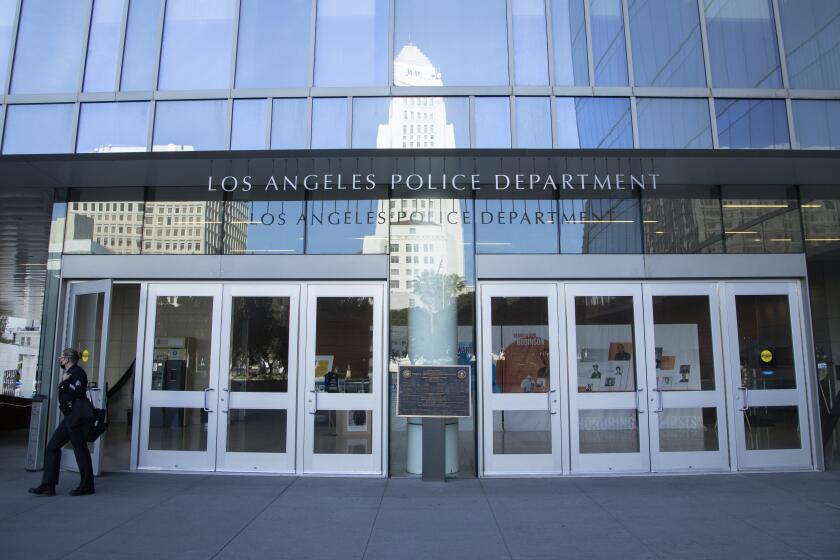City Changed Into Urban Center During Turbulent ’89 : Looking Back: Glendale experiences an apartment moratorium battle, a hotly contested City Council election, runaway school crowding and emerging gang violence.
1989 was the year Glendale became a metropolis.
It was a year of turmoil, and the city’s leaders as much as conceded that the small-town era of polite stewardship by a benevolent clique has become a thing of the past.
Beginning with a rough-and-tumble battle over an apartment construction moratorium, the year also brought the city’s most hotly contested election campaign ever, runaway school crowding and the emergence of gang violence. City services were stretched by new waves of non-English-speaking immigrants, and the city faced the prospect of its first deficit budget.
Once known as a mostly white, upscale bedroom community--a nearby retreat from Los Angeles’ urban woes--Glendale seems to have suddenly awakened to discover that it is urban, dynamic and diverse.
Public spending jumped to levels previously unheard of, and the City Council adopted more laws than ever before. It was the year that Glendale’s government tossed out its traditional hands-off approach in a last-ditch attempt to keep the city the way it was.
“In the old culture of Glendale,” Mayor Jerold Milner said, “the basic political conservative philosophy was to leave as many decisions as possible to the individuals. But these days, people are asking the government to protect their quality of life, so we have to intervene.”
The year’s biggest battle was fought over the growth of south Glendale neighborhoods zoned for apartment construction. The issue remains unresolved.
In September, 1988, the council quickly and unexpectedly enacted a citywide moratorium on apartment construction. The city spent most of 1989 in court defending the moratorium against attacks by developers whose projects had been stalled in the plan-approval stage.
A Superior Court judge ruled in November that the 20 or so projects held up by the moratorium should be allowed to proceed, but the council immediately approved an ordinance that prevented any additional apartment construction.
The new freeze avoided the legal glitches of the first one. So far it has not been challenged.
Both moratoriums were adopted for the same reason--to give voters time to approve a slow-growth ordinance to keep the city’s population within the 200,000-220,000 range, as recommended in its General Plan.
The new ordinance requires an extensive environmental impact review in which the city will have to justify why Glendale needs to stop growing. City planners acknowledge that finding a legal justification for stopping growth won’t be easy.
The city’s rampant growth seems to respond more to international events and national trends than to local politics. About 25,000 new residents arrived in the past decade--mostly from Armenia and Mexico--with more than 3,000 coming in the past year alone. The flood of immigrants, which swelled the city’s population to about 165,000, has created an unprecedented strain on city services.
Most burdened are the schools and the Police Department, but public housing, sewer usage and refuse collection have also been affected.
Plans were drawn to expand the city’s sewer capacity, and a mayor’s task force was formed to propose garbage disposal alternatives to extend the life of Scholl Canyon landfill, which is filling up.
This also was the year that the phrase “affordable housing” became part of the City Council’s vocabulary.
“A couple of years ago the phrase ‘affordable housing’ was a very unpopular cliche,” Councilman Larry Zarian said. “But my own sons have grown up and can’t afford to stay in the city. To me that realization was a very awakening thing. We can’t allow Glendale to become a city only for the wealthy.”
After years of delays, the city accepted a state mandate and set aside $2.9 million in property taxes from its redevelopment zone to finance low-income housing programs, with almost all of the money going to land purchases and developer incentives for three senior citizen housing projects.
About the same time, officials learned firsthand that city residents are in dire need of direct housing subsidies.
In June, more than 3,000 applicants--the vast majority recent immigrants from Soviet Armenia--erupted in a semi-riot during a sign-up session for federal housing vouchers in a south Glendale park.
Their names were added to a waiting list of 1,400 for the city’s 1,000 federal rent subsidies. Five months after the incident, the City Council voted to fund rent subsidies for the first time to complement the federal program--$200,000 for 60 rental units.
Enrollment in the Glendale Unified School District rose to 24,000, up by more than 1,000 from the year before and the highest in the past two decades.
The classrooms have become increasingly diverse, increasing the demand for teachers with foreign language skills. The annual ethnic survey released by the district this year showed that enrollment by Middle Eastern students, which include Armenians, jumped nearly 4% to just under 6,000 students. Latino enrollment reached 5,800 after a modest increase this year, and minority enrollment overall remained steady at about 42%.
The city’s runaway growth placed unprecedented demands on the Police Department to fight urban crimes such as auto theft and gang violence, and to control traffic and monitor anti-abortion demonstrations.
It was the year that Glendale witnessed its first drive-by killing and formed its first police gang unit. Auto theft became the No. 1 crime. The bulk of police overtime hours was spent monitoring Operation Rescue rallies at clinics and hospitals that perform abortions. Directing traffic became an everyday endeavor. Violent crime went up 23%.
The urban-type crimes prevalent today, Police Chief David Thompson said, demand more police officers than those in the past. “The burglary rate has gone down, but there’s been an auto theft explosion,” he said.
The Police Department added 17 officers this year, more than the total increase in the entire decade. Thompson used the additional positions to create an anti-gang unit and to beef up motorcycle and foot patrols.
As a result of the city’s growth, the city government had to grow too.
In the past decade, city budget increases rarely exceeded the growth in the cost of living, and never by much. A city that prides itself on fiscally sound, penny-wise spending habits, Glendale never took on long-term debt and rarely dipped into its reserves. But the city’s 1989-90 budget grew by a record 11%, almost three times higher than the increase in the cost of living.
“This city is not known for its dynamic growth and new programs,” said Finance Director Brian Butler after the budget was announced in May. “It’s an old, conservative city. After this year’s growth spurt, we should return to the days of controlled growth.”
The bulk of this year’s budget increase was used to hire 61 new workers to meet the increasing demand for city services; only 13 new workers were hired the previous year.
A new city department--Neighborhood Services--was created for the first time in 20 years. Several new offices, including permit services, graphics, volunteer services and the hazardous materials team, were added to the city bureaucracy.
The city once renowned for its conservative, hands-off government adopted a flurry of ordinances to control everything from the location of news racks to the size, height and “neighborhood compatibility” of all new houses, apartments and condominiums.
Many of the city’s new ordinances and resolutions were aimed at taming the effects of rapid growth and urbanization.
Liquor sales in gas stations were outlawed, and laws were passed to discourage X-rated bookstores from opening in the city. Size limits were imposed and a stringent review process was created to control the construction or major expansion of single-family houses.
A city initiative to ban overnight parking in south Glendale’s dense neighborhoods was postponed after angry crowds flocked to the City Council chambers to speak against the proposal.
And the city struggled unsuccessfully all year to establish an official pickup site away from the heart of the commercial district for the increasing number of day laborers that now congregate on a street corner to solicit work.
The pressures and tensions that accompany periods of transition surfaced in the most hotly contested City Council election since the 1930s. Thirteen candidates vied for three council seats in the April election.
Not surprisingly, “Preserve traditional Glendale” was the campaign slogan shared by the City Council incumbents and Dick Jutras, a longtime city insider and former planning commissioner. Jutras won the seat of John F. Day, who retired.
The incumbents were comfortably reelected, but their margin was significantly smaller than in previous elections. More than half the voters chose non-incumbents, but the 10 challengers split and diluted the protest vote.
South Glendale, with its moderate-income, politically lethargic and mostly ethnic minority population, mounted its biggest challenge yet to the political hegemony of the city’s affluent northern neighborhoods.
Two south Glendale candidates ran in April on south Glendale platforms, creating enough interest to double the negligible voter turnout south of the Ventura Freeway.
One of them, Berdj Karapetian, outspent everyone, including the incumbents. But his attempt to forge an alliance of apartment renters, liberal Democrats, low-income senior citizens, Armenians and Latinos fell far short of challenging the political establishment of wealthy, Republican homeowners in north Glendale.
Though soundly defeated, Karapetian said his work has just begun. “It takes a lot more time and education than a two-month campaign to get people to feel they have an interest to protect,” he said, after learning that he placed 11th with 3.4% of the vote.
The April elections also marked the first serious incursion into city politics of the fast-growing Armenian community.
The Armenian National Committee, headquartered in Glendale, held its largest-ever voter registration drive and endorsed two Armenian-Americans as opposition candidates. It was the first time that three Armenian-Americans ran for the City Council.
Armenians comprise one-fifth of the city’s population, although fewer than 2,000 are registered to vote. If they register in greater numbers, they could become a force in Glendale’s political future.
There was yet another--and perhaps more significant--development in the aftermath of the April election. The other south Glendale candidate, Robin Westmiller, formed a group that is now collecting signatures to force a change from at-large to council district elections.
If her initiative succeeds, three council members who live within blocks of each other will have to fight for a single seat. The power of the homeowners associations--virtual political machines in their ability to turn out the vote for the north Glendale incumbents and their heir apparents--will drastically diminish. And south Glendale could have hopes of gaining its first-ever elected councilman.
If 1989 is any indication of what lies ahead, Glendale will never be the same again.
More to Read
Start your day right
Sign up for Essential California for news, features and recommendations from the L.A. Times and beyond in your inbox six days a week.
You may occasionally receive promotional content from the Los Angeles Times.






